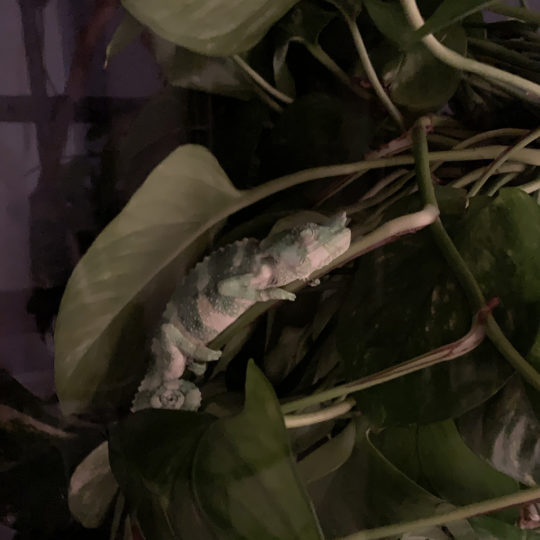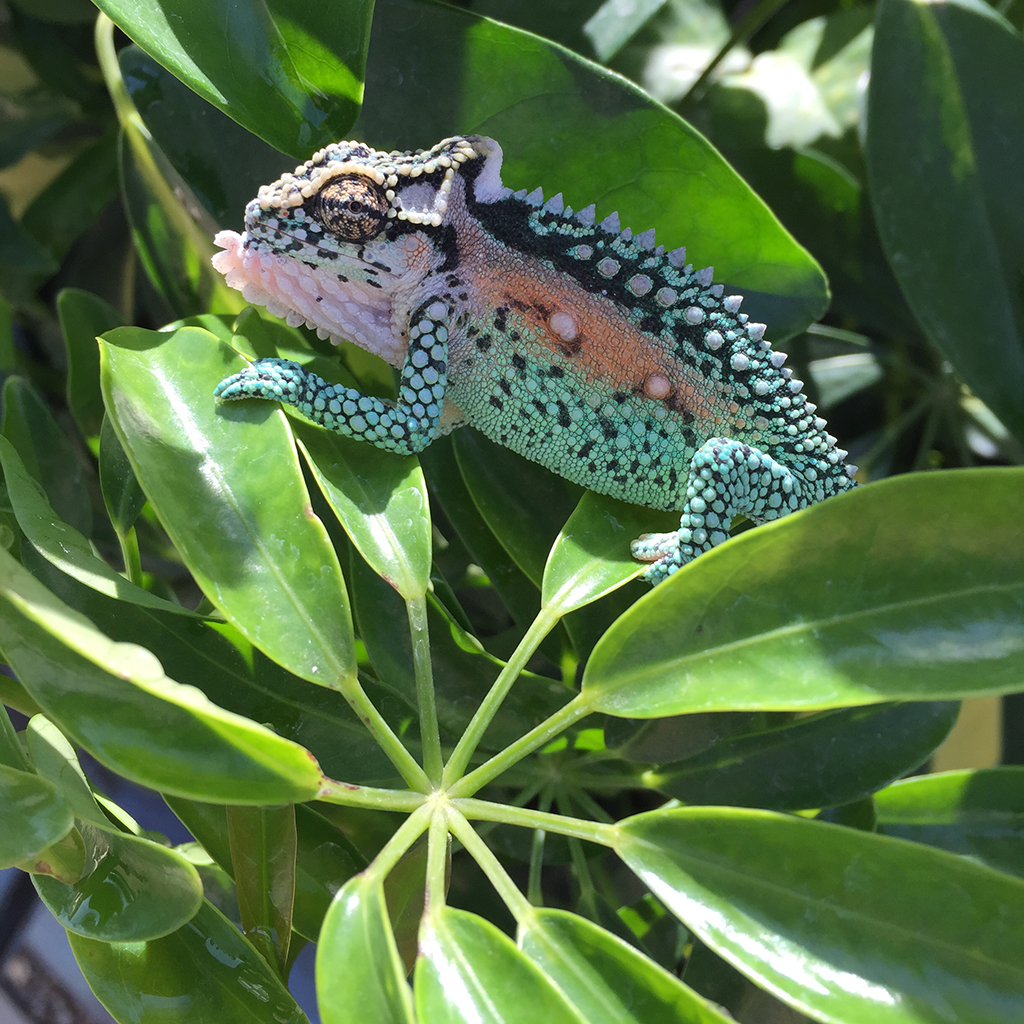Summary: Chameleon Lighting
- Chameleons need a brightly lit cage environment
- Chameleons need darkness at night – no lights (they can see red)
- T5 High Output Fluorescent bulbs are the lighting technology of choice
The Importance of Light to Your Chameleon

Chameleons are visual animals. Their vision is highly developed and light is what fuels this sense. There is evidence that they see beyond the spectrum that we see. Pictures taken with cameras tuned to the ultraviolet spectrum show a dazzling array of patterns on chameleons. It is certain that we would be fascinated to see the world perceived as a chameleon does.
Thus the importance of light to a chameleon. Too often chameleon cages are the equivalent of dark caves! Your chameleon cage must be bright and well lighted for your chameleon to have a healthy life.
Sunlight has different components to it including vision for navigating this world, UVB to create vitamin D3, and heat to regulate temperature. We will cover each one of these functions individually as they are usually produced with different types of lights.
In this module we are talking about light for vision. Sunlight also provides UVB for vitamin D3 synthesis and heat. Though, there are even more wavelengths beyond these and breaking sunlight up into only these three can be deceptive. Vision, UVB, and heat are the most important component s to be aware of when you are starting out, but be prepared to be introduced to a fascinating education as you grow in the chameleon arts. UVB and heat will be covered in their own modules after this one.
Light for Vision

Our technology has advanced to where we can reproduce each of the components of sunlight: vision, heat, and UVB. The most common and effective technologies require different bulbs for each of these three components. Technologies such as Mercury Vapor and Metal Halide bulbs can combine all three, but are not yet firmly established in chameleon husbandry.
For many years, the best source of light, as far as efficiency, was in the form of T5 high output fluorescent lights. These were the most effective bulbs commonly available for providing light for vision. For bright daylight, a 6500K T5 High Output linear fluorescent bulb were, and still can be, the bulb of choice. A quad fixture holding three 6500K bulbs and one UVB bulb is an effective solution for a chameleon cage.
Fluorescent bulbs, though, are starting to get banned in many areas of the world. Although exceptions are being made for specialty lighting and there certainly will be a long transition out of fluorescents, We need to be actively evaluating the new LED light bars coming into the market.
Light During the Night

Pet stores often send new keepers home with a red heat bulb for nighttime heating. This is unnecessary and can be unhealthy. Unfortunately, despite what is said at some points of sale, chameleons can see the red light and it disrupts their sleep patterns. Give chameleons as dark of a sleeping area as possible. And, as you will learn in the heating section, additional heating at night is not only not necessary, but, much of the time, is unhealthy. Especially with Jackson’s Chameleons, a night time temperature drop is critical. If you are in a situation where nighttime heating is necessary, do so without light.
Your Lighting Cycle

Most chameleons will do well with a 12 hours on and 12 hours off light cycle which is what is found at the equator. Though some species of chameleons are found quite far from the equator and the ones at the furthest latitudes away (Spain and South Africa) will experience daylight variations that go from 9 hours to 15 hours throughout the year.
The change in daylight hours may play a role in signaling the mating seasons, but at this point, a 12 hour daylight and 12 hour night is an effective initial set up. You are welcome and encouraged to check the daylight variations of the chameleon’s home country to replicate it. The more in tune you are with your chameleon’s home range the better. But a simple 12 on/12 off will work for keeping chameleons healthy – even the ones from the outer edges of the chameleon ranges.
Integrating the Sun into your Captive Husbandry

There is nothing that can truly replace the sun and you should integrate unfiltered sunlight into your husbandry as much as possible. But, there are complications. First of all, sunlight coming through glass can provide warmth and light to see, but glass filters out the UVB so it is what we call “filtered”. It is exposure to natural unfiltered sunlight that has the great benefit we are looking for.
Though it is easy to get too much of a good thing. Exposure to the sun can easily overheat your chameleon if it is in a cage and does not have a place to escape. It is the same with us. If we were put into the sun without being able to escape we would burn and overheat. It is no different for a chameleon. There are many options for outdoor keeping. It is worth incorporating them, but they must be done carefully.
Reference the discussions on outdoor caging for bringing chameleons outdoors.
To integrate sunlight into indoor keeping this requires opening a window and not having glass between the sun and the chameleon. When doing this always ensure that there is an escape for the chameleon to get out of the sun. It is very easy for the sun to bake a certain area that it is direct contact with.
Navigation
This seminar is part of the introductory course Chameleon Basics which, in turn, is a module within the even larger Term 1: Getting Started With Chameleons.




